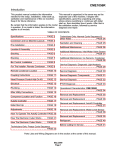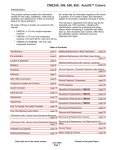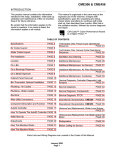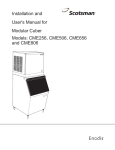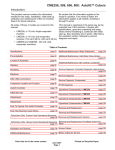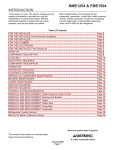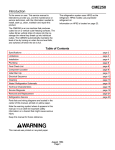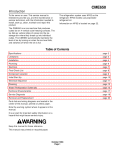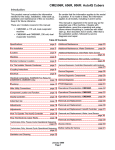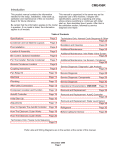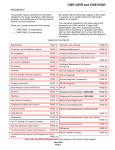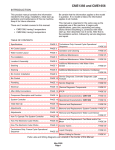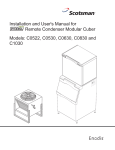Download Scotsman CME1056 Product manual
Transcript
CME1056 INTRODUCTION This product manual contains the information needed for the setup, installation, initial start up, sanitation and maintenance of this ice machine. Keep it for future reference. Be certain that the information applies to the model in question. If no model is listed, the information applies to all models. This manual is organized in the same way as the expected use of the machine, it begins with specifications, goes thru unpacking and setup, shows where everything is; continues with initial start up, then describes how it works. After that is the sanitation section, followed by service diagnosis and repair. CM Cubed™ Cuber Performance Raised to a Higher Power.™ ™ TABLE OF CONTENTS Specifications , , , , , , , , , , , , , PAGE 2 Air Cooled Layout , , , , , , , , , , , PAGE 3 Water Cooled Layout , , , , , , , , , PAGE 4 Pre-Installation , , , , , , , , , , , , , PAGE 5 Location & Assembly , , , , , , , , , PAGE 6 Cabinet Panel Removal: , , , , , , , , PAGE 7 Stacking: Requires Kit , , , , , , , , , PAGE 8 Stacking , , , , , , , , , , , , , , , , PAGE 9 Technicians Only: Harvest Cycle Operational Sequence , , , , , , , , , , , , , , , PAGE 23 Sanitation and Cleaning , , , , , , , , PAGE 24 Additional Maintenance , , , , , , , , PAGE 25 Additional Maintenance: Ice Sensors and Water Level Sensor , , , , , , , , , , , , , , PAGE 26 Additional Maintenance: Air Filter Replacement , , , , , , , , , , , , , , , , , , , , , PAGE 27 Additional Maintenance: Condenser , , PAGE 28 Bin Thermostat: Installation , , , , , , PAGE 10 Service Diagnosis: Controller Diagnostic Light Analysis , , , , , , , , , , , , , , , , PAGE 29 Plumbing - Air Cooled , , , , , , , , , PAGE 11 Service Diagnosis , , , , , , , , , , , PAGE 30 Plumbing - Water Cooled , , , , , , , PAGE 12 Service Diagnosis: Components , , , , PAGE 31 Electrical , , , , , , , , , , , , , , , , PAGE 13 PTCR Diagnosis , , , , , , , , , , , , PAGE 32 After Utility Connections , , , , , , , , PAGE 14 Operational Characteristics: CME1056 PAGE 33 Component Description and Function , PAGE 15 Removal and Replacement: Water Level Sensor , , , , , , , , , , , , , , , , , , , , , PAGE 34 AutoIQ Controller , , , , , , , , , , , PAGE 16 How To Operate The Controller , , , , PAGE 17 Removal and Replacement: Fan Blade and/or Fan Motor , , , , , , , , , , , , , , , , , , PAGE 35 Initial Start Up , , , , , , , , , , , , , PAGE 18 Access Valves , , , , , , , , , , , , , PAGE 36 Adjustments , , , , , , , , , , , , , , PAGE 19 Before Calling for Service , , , , , , , PAGE 37 How This Machine Works , , , , , , , PAGE 20 How This Machine Works , , , , , , , PAGE 21 Technicians Only: Freeze Cycle Operational Sequence , , , , , , , , , , , , , , , PAGE 22 Parts Lists and Wiring Diagrams are Located in the Center of this Manual May 2000 Page 1 CME1056 Specifications This ice machine is designed to be installed indoors, in a controlled environment. It will operate satisfactorily under a wide variety of conditions. Do NOT operate the machine in temperatures it has not been designed for. Do NOT operate the machine above or below the voltage limits for the particular model. Do NOT operate the machine with too little or too much water pressure. Operational Limits In addition, there may be other bins that can be used, check Scotsman’s sales literature for application information. Kits: • BH800 bin: Add kit KBT23 • BH900 bin: Add kit KBT22 • ID200 or ID250 Dispenser: Add adapter kit Minimum Maximum Air Temperature 50oF. 100oF. • Water Temperature 40oF. 100oF. • Water Pressure 20 psi 80 psi Voltage (60 Hz model) 198 253 Voltage (50 Hz model) 207 253 • Inlet water flow required is 2.7 GPM. • All models will fit a standard, 30" wide Scotsman Ice Storage Bin. Some examples are: • BH550 • HTB555 KBT44. Do not deploy the CME1056’s thermostat. Lancer 30” wide dispenser. Add adapter kit KSTAT-MD Cornelius ED200 dispenser requires adapter kit from Cornelius. Do not deploy the CME1056’s thermostat. Other combinations may be available. See Scotsman product literature for more information. Stacking two CME1056s together requires stacking kit: KSCME6-MD (cannot stack any other model with a CME1056). Scotsman reserves the right to make design changes and/or improvements at any time. Specifications and designs are subject to change without notice. Note: Slope front bins must have an internal baffle. Scotsman BH550 and HTB555 have the required Scotsman assumes no liability or responsibility of baffle. Baffle must be approximately in the position any kind for products manufactured by Scotsman shown in the diagram on page 5. that have been altered in any way, including the use of any parts and/or other components not specifically approved by Scotsman. Basic Information Model Number Dimensions W" x D" x H" (w/o bin) Basic Electrical Maximum Fuse Size Refrigeran t Charge (R-404A) CME1056AS-32F 30 ½ x 24 x 28 208-230/60/1 Air Cooled 18.75 20 44 ounces CME1056WS-32F same 208-230/60/1 Water Cooled 17.25 20 28 ounces CME1056AS-3F same 208-230/60/3 Air Cooled 13.63 15 44 ounces CME1056WS-3F same 208-230/60/3 Water Cooled 12.13 15 28 ounces CME1056AS-6F same 230/50/1 Air Cooled 44 ounces CME1056WS-6F same 230/50/1 Water Cooled 28 ounces Condenser Type May 2002 Page 2 Minimum Circuit Ampacity CME1056 Air Cooled Layout 6.00 in 15.2 cm MINIMUM FOR UTILITY CONNECTIONS 2.70 in 6.9 cm PLAN VIEW ICE OPENING 9.85 in 25.0 cm 6.00 in 15.2 cm MINIMUM FOR AIR VENTILATION 18.70 in 47.5 cm ICE OPENING January 2003 Page 3 1.63 in 4.1 cm 6.00 in 15.2 cm MINIMUM FOR AIR VENTILATION CME1056 Water Cooled Layout 6.00 in 15.2 cm MINIMUM FOR UTILITY CONNECTIONS PLAN VIEW 2.70 in 6.9 cm 9.85 in 25.0 cm 18.70 in 47.5 cm 1.63 in 4.1 cm ICE OPENING .88 DIA. KNOCKOUT ELECTRICAL INLET CONDENSER INLET 3/8" F.P.T. WATER INLET 3/8" FLARE 21.75 in 55.2 cm 15.53 in 39.4 cm 17.68 in 44.9 cm BACK VIEW 10.25 in 26.0 cm CONDENSER DRAIN 1/2" F.P.T. 4.31 in. 10.9 cm SUMP DRAIN 3/4" F.P.T. 10.75 in 27.3 cm 23.06 in 58.6 cm 26.35 in 66.9 cm May 2000 Page 4 2.38 in 6.0 cm 4.75 in 12.1 cm SIDE VIEW 24.00 in 61.0 cm ICE OPENING CME1056 Pre-Installation Other Applications: Check Scotsman sales information for recommendations regarding applications. Do not place Air Cooled models where the noise from the fan will be objectionable. Check the nameplate for electrical requirements. The nameplate is located on the back of the ice machine. While the model and serial number are on the nameplate, a serial number plate is located at the front of the machine, near the purge valve. Water: There is no such thing as pure water. All water contains some impurities. There are two ways water carries the impurities: suspended and dissolved. Suspended solids can be filtered out. Dissolved solids must be diluted or treated. Water filters are recommended to remove suspended solids. Some filters also have treatment in them for dissolved solids. Check with a water treatment service for a recommendation. Nameplate on Back Panel Serial Number Plate, Remove Front Panel to Locate Service Technicians: All models covered here come set from the factory at a “standard” water rinse, which is compatible with typical water conditions. They may be adjusted to “Minimum" or “Maximum" water rinse after start up. If the prior ice machine worked acceptably well with the local water conditions, leave the machine at the factory setting. If severe water conditions are present, and water filters do not solve the problem acceptably, adjust the machine to use more water. If water conditions are excellent, adjust the machine to use less water. See the Adjustments section. Note: Water use adjustments are customer convenience adjustments; they are NOT factory defects and are NOT covered by warranty. May 2000 Page 5 12.0" Side View 4.0" Cube Ice machines use more water than what ends up in the bin as ice. While most water is used during ice making, a portion is designed to “rinse" out the water system to keep hard water scale from clogging up the machine. That water rinse, Note: Slope front bins must have an internal baffle. combined with water filters, prolongs the times Scotsman HTB555 and BH550 have the required between needed water system cleaning. baffle. Baffle must be approximately in the position 3 shown in the diagram. Note: All Scotsman CM models, like those described in this manual, feature Scotsman’s AutoIQ™ control system and ReliaClean™ water Baffle system cleaning process. CME1056 Location & Assembly Air cooled models take room temperature air in from the sides and discharge warm air out the back. Do not place them where the heat and noise will be objectionable. Remove Air Baffle from its Shipping Position. Use baffle for In-The-Corner Applications A 6 inch MINIMUM clearance on the back, and both sides is required for the basic operation and service of the air cooled model. Back View of Ice Machine Air Cooled Condenser Outlet Airflow is in the sides and out the back Attach Air Baffle Here Air Baffle Attach Air Baffle Here Baffle Position Ice Machine Top View Note: A six inch side clearance with zero top clearance will NOT provide enough air exchange space for optimum performance. 12 inches side clearance is required when there is no top clearance. Unpacking and Assembly: Begin with unpacking the ice storage bin. Remove the carton, and using part of the carton as a cushion, tip the bin on its back to remove the skid and attach the legs or casters. Note: Stacked applications may not use casters. Wall Baffle Baffle Ice Machine Top View Wall Ice Machine Top View Wall 17-2632-01 Rev. A. Air cooled models come equipped with a baffle that can be used when the machine is installed in a corner. The purpose of the baffle is to limit air recirculation. This can occur in a corner when the hot air from the back of the machine is re-drawn back into the machine from the nearest side of the machine. Return the bin to an upright position. Check the bin top gasket for gaps and tears, fill any in with food Install the air baffle as shown. Place the baffle: grade sealant prior to placing the ice machine on • On the left rear corner when the left wall and the bin. back wall are between 6 and 18 inches from Level the top edge of the bin front to back and the unit. left to right. • On the right rear corner when the right wall and back are between 6 and 18 inches from If the ice machine has not been unpacked, do so the unit. now. Remove the carton from the skid. After removal of the shipping straps, lift the ice machine off the skid directly onto the bin. Note: The machine is heavy! Use a mechanical hoist if necessary. Secure the ice machine to the bin with the hardware provided (two metal straps and 4 bolts). May 2000 Page 6 CME1056 Cabinet Panel Removal: Note: The top panel holds the upper edges of the side panels in place. 1. Remove the front panel by removing the two screws connecting the top edge of the front panel to the machine, then pull out at the bottom. 2. Lift up at the front edge and push the top panel back until it releases from the tabs connecting it to the back panel. 3. Remove the screws at the front edge of the left side panel, and pull forward until it releases from the tabs connecting it to the back panel. Remove The Front Panel First May 2000 Page 7 CME1056 Stacking: Requires Kit Only like models may be stacked. Begin after the Upper Machine: bottom unit has been placed on the ice storage bin and secured. Stacking requires heavy duty leg kits. 8. Knock out 1 hole in the lower left (viewed from the front) corner of the upper unit’s back panel. Casters are NOT recommended. Bottom Machine: Lower Unit: 1. Remove front, side, and top panels. 9. Knock out 1 hole in the upper left (viewed from the front) corner of the lower unit’s back panel. 2. Hang the plastic shield from the tabs on the stainless steel bracket. 3. Locate the two notches on the sides of the top edge of the freezing compartment. 10. Position the strain reliefs over the wrapped portion of the stacking kit wire harness. 11. Route the Stacking Kit wire harness from the back to the top and bottom machines thru the holes made in steps 8 and 9. The harness is marked which end goes to which machine. Notch Push the strain reliefs into place from the back of the machines. Follow local codes for 24 volt wire 12.Route wire harness in lower ice machine to the controller. Connect to terminal #7. Plug the two free wires onto thermostat terminals #1 and #2 4. Place the bracket over the notches of the freezing compartment. Routing of Harness Bracket Shield 5. Secure bracket to freezing compartment with screws from the kit (from the sides). 6. Locate gasket material in kit. Place a layer of gasket material on the top edge of the plastic freezing compartment. 7. Place the top ice machine onto the bottom one. Secure together with hardware from the top machine. Remove front and left side panels. May 2000 Page 8 CME1056 Stacking Top Machine: 13. Route the wire to the controller. Connect to terminal 7. 15. Mount the bulb of the thermostat to the bracket from the kit. Bottom Machine 16. Install the bin thermostat bracket onto the bottom of the machine. 17. Pull back excess cap tube and coil up in the machine. 14. Route the bulb of the thermostat thru the base of the unit into the bin. 18. Connect wires from harness to thermostat terminals. Both Machines: 19. Return all panels and covers to their normal positions. 20. Complete the balance of the installation. March 1999 Page 9 CME1056 Bin Thermostat: Installation The bin control is a thermostat. Its bulb must be deployed after the ice machine has been placed on the bin or dispenser. 5. Fasten the bracket to the bottom of the ice machine with the two 3-pronged knobs supplied with the unit. Before starting, remove the left side panel and any baffle in the bin. 1. Locate bin thermostat bulb. 2. Route bulb thru routing hole (located between the compressor and the reservoir). Routing Hole 6. Pull back into the ice machine any excess capillary tubing. 7. Return the baffle to the bin and continue with the installation. Bin Thermostat Altitude Correction Table CW Turns of Range Screw (under plastic cover) 3. Locate bin thermostat bracket. Feet Turns Feet Turns 4. Carefully position the thermostat bulb on the bracket. 2000 55o 8000 340o 4000 160o 9000 385o 6000 250o 10000 405o Use This Table to Adjust Thermostat Insert Tip May 2000 Page 10 CME1056 Plumbing - Air Cooled All models require an adequate potable water supply and a gravity drain. The recommendations for tubing are: • Water supply to be 3 8" OD. • Drain to be 3 4" OD. Drain: Note: When replacing a prior ice machine, do not take a short cut and reuse the old inlet and drain system. INSTALL A NEW SYSTEM. Supply: All Drain Tubing Material must be RIGID. Flexible tubing will eventually cause a restricted drain. Air cooled models have 1 gravity drain connection, a 3 4" FPT fitting at the back of the cabinet. Use only RIGID TUBING. Flexible tubing may be easily kinked or become cracked. The drain tube must be vented at the back of the cabinet. Use an 18" high vent. Air cooled models have 1 water supply connection, The ice storage bin will have a drain out the back or a 3 8" male flare at the back of the cabinet. Connect base, depending upon the model. to cold potable water that has adequate pressure. The drain for the ice machine and the ice storage Note: Using water supply tubing smaller than 3 8" bin must be SEPARATE or the ice machine’s drain will cause severe operational issues. water may run into the bin and MELT THE ICE. Water Filters: Insulation is recommended for the ice machine reservoir and bin drains. The water filters must flow at least 2.7 GPM or they Follow all applicable codes will cause severe operational issues. Check with the filter manufacturer. When replacing a prior ice machine, do NOT assume that the water flow capacity of the filter will be adequate. Water Inlet System Water IN Water OUT Vent this Drain Bin Drain Plumbing Connections May 1999 Page 11 CME1056 Plumbing - Water Cooled All models require an adequate potable water supply and a gravity drain. The recommendations for tubing are: • Water supply to be 3 8" OD. • Drain to be 3 4" OD. When replacing a prior ice machine, do NOT assume that the water flow capacity of the filter will be adequate. All Drain Tubing Material must be RIGID. Flexible tubing will eventually cause a restricted drain. Note: When replacing a prior ice machine, do not take a short cut and reuse the old inlet and drain system. INSTALL A NEW SYSTEM. Supply: Water cooled models have TWO water supply connections, a 3 8" male flare for POTABLE water AND an additional 3 8" FPT condenser inlet connection, both at the back of the cabinet. Connect both to cold water w/adequate pressure. Note: Using water supply tubing smaller than 3 8" will cause severe operational issues. Water Filters: The water filters must flow at least 2.7 GPM to the potable water inlet or they will cause severe operational issues. Check with the filter manufacturer. Drain: Water cooled models have TWO gravity drain connections, a 3 4" FPT fitting AND a ½ “ FPT fitting. Use only RIGID TUBING. Flexible tubing may be easily kinked or become cracked. The reservoir drain must be vented at the back of the cabinet. Use an 18" high vent. Do NOT vent the condenser drain. The ice storage bin will have a drain out the back or base, depending upon the model. The drain for the ice machine and the ice storage bin must be SEPARATE or the ice machine’s drain water may run into the bin and MELT THE ICE. Insulation is recommended for the ice machine reservoir and bin drains. Follow all applicable codes Water Inlet System Potable Water IN Do NOT Vent the Condenser Drain Water OUT. VENT THIS DRAIN Bin Drain Plumbing Connections May 2000 Page 12 CME1056 Electrical All models must be installed with the correct wire Follow all Local, State and National codes. size and type per the National Electric Code. Locate the nameplate on the back of the cabinet and find the numbers for Voltage, Phase, Minimum Circuit Ampacity and Maximum Fuse Size. Either fuses or HACR type circuit breakers may be used. Electrical connections are made in the junction box in the back of the cabinet. 1. Remove the junction box cover. 2. Knock out 1 hole for a field supplied strain relief. 3. Install wires and strain relief per code. 4. Connect to wires and secure ground wire to ground screw inside the junction box. Electrical Power Supply Power IN Power Supply Connections May 2000 Page 13 CME1056 After Utility Connections 1. Level the cabinet, use the leg levelers on the end of the legs to adjust the cabinet height. 2. Wash out the bin. If desired, the interior of the bin could be sanitized. 3. Locate the ice scoop (if supplied) and have it available for use when needed. Final Check List: ____1. Is the unit located indoors in a controlled environment? ____2. Is the unit located where it can receive adequate cooling air? ____3. Has the correct electrical power been supplied to the machine? ____4. Have all the water supply connections been properly made? ____5. Have all the drain connections been properly made? ____6. Has the unit been leveled? ____7. Have all unpacking materials been removed? ____8. Has the bin control been installed? ____9. Is the water pressure adequate? ____10. Have the drain connections been checked for leaks? ____11. Has the bin interior been wiped clean or sanitized? ____12. Have any water filter cartridges been replaced? May 2000 Page 14 CME1056 Component Description and Function Reservoir: Contains the water for ice making. Water Inlet Valve: Opens to allow water into the reservoir. Cube Deflector: The slots in the inclined deflector allows the water falling from the evaporators back into the reservoir, but when ice falls during harvest, the ice slides off the deflector into the bin. Water Level Sensor: Controls the size of the ice cube by measuring how much water is used in a cycle. It consists of a float, stem and electric eye. The stem will move slightly when the pump is on, this is normal. As the machine makes ice the reservoir water level will fall and the visible portion of the stem will slide down thru the slot in the sensor body. Refrigeration Service Access Valves: Only to be used by a certified technician. Allows access to the refrigeration system for diagnostic information. Evaporators/Freezing Compartment: Location of the evaporators. Ice forms on the evaporators and is released when warmed up during the harvest cycle. The freezing compartment is fully insulated for maximum efficiency. Purge Valve: Opens during the early part of the harvest cycle to drain the reservoir. Water Pump: Forces the water from the reservoir to the top of the evaporators. The motor is separated from the reservoir water to minimize contact with the water. Ice Sensor: A photo-electric eye set, located at the front and back of the cube port. Service Valves Evaporators Purge Valve Water Inlet Valve Water Level Sensor Water Pump Reservoir Ice Sensor Component Location May 2000 Page 15 CME1056 AutoIQ Controller Indicator Lights: Cycle Definitions: • Bin Full: On when bin is full, goes on and • • • • • • off as ice falls during a harvest cycle. Freeze: On when the unit is in the Freeze cycle, blinks when a freeze mode is pending. Harvest: On when the unit is in the Harvest cycle. Clean: On when the unit is in the Clean cycle, blinks when preparing for a clean mode. Off: On when the unit has been switched off, blinks when the machine is preparing to shut off. Water: On when the controller has identified a problem with the water system. Refrigeration: On when the controller has identified a problem with the refrigeration system. LOW VOLTAGE IN/OUT WATER VALVE HOT GAS VALVE PURGE VALVE TIMER CONTACTOR COIL STACKING and/or THERMOSTAT FUTURE USE RESERVOIR & DISCHARGE LINE THERMISTORS 9 HI VOLTAGE IN/OUT WATER PUMP 7 PUSH BUTTON CONTROL SWITCHES 6 5 4 ICE SENSOR 3 FACTORY USE operating to remove heat from the evaporators. The compressor, fan motor (if air cooled) and water pump are ON. • Harvest: The refrigeration and water systems are operating to harvest the ice cubes. While the compressor is on for the full cycle, the water pump will be off at the beginning and inlet water valve will switch off before the end. • Clean: The Inlet Water Valve opens to fill the reservoir. The Water Pump starts. The Clean indicator light is switched ON. A manually initiated rinse flushes the system. 8 ICE SENSOR RESERVOIR WATER LEVEL SENSOR • Freeze: The refrigeration system is INDICATOR LIGHTS: BIN FULL FREEZE HARVEST CLEAN 2 OFF DIAGNOSTIC LIGHTS: WATER 1 REFRIGERATION May 2000 Page 16 CME1056 How To Operate The Controller The Controller is a microprocessor based device that receives input from several sources and switches various components on and off. To Reset Machine (machine off, error light on): First push and release the Off button, then push and release the Freeze button. Its manual control is thru the use of the Push Button Control Switches Diagnostic Light Recall 8 To recall the last error on the blue housing CM3 controller: 1. Switch the unit OFF by holding the OFF button for longer than 3 seconds. 9 2. Hold the Off button down again until the Purge Setting indicators (Green Lights) are on. 3. Push and release the Harvest button. 7 6 5 4 3 PUSH BUTTON CONTROL SWITCHES INDICATOR LIGHTS: BIN FULL FREEZE 1 Push the Harvest button again and the second-to-last error code will be displayed. The bin full light will also be on to signal that this is the second-to-last code. Pushing the Harvest button again will display the last error code again. Only two error codes are available for display. HARVEST CLEAN 2 The last error code stored in the controller will be displayed and the purge setting will disappear. OFF DIAGNOSTIC LIGHTS: WATER REFRIGERATION If no error code exists, no code will be displayed and there will be NO LIGHTS showing. To return from the display of the last error, do nothing for 60 seconds or push and hold the Off button. 1. Freeze Button. Pushing and releasing this button starts or restarts the machine. The AutoIQ After returning from the display of the last error Controller remembers what cycle it was last in and (Off light glows), the machine may be returned to returns to that cycle. the ice making process by pushing and releasing the Freeze button. 2. Harvest Button: Pushing and releasing this button will cause the machine to go directly to a Harvest Cycle. Can be done from Freeze or Off. The machine will switch Off at the end of the Harvest cycle. 3. Clean Button: Pushing and releasing this button will cause the machine to empty the reservoir, refill and leave only the water pump on for circulation of ice machine cleaner. After the ice machine cleaner has circulated for about 10 minutes a second push of this button will switch on the rinsing system to flush out the dissolved scale and ice machine cleaner. 4. Off Button: Pushing and releasing this button will switch the machine OFF at the end of the next cycle. If the button is pushed and HELD for more than 3 seconds, the unit will switch off immediately. March 2003 Page 17 CME1056 Initial Start Up • The Bin Full indicator light will go on and off 1. Remove the front panel. as ice falls from the evaporators. 2. Locate the AutoIQ Controller. 3. Switch on the electrical power. Note that the controller’s indicator lights all flashed on briefly and then the two red lights began to blink on and off while the Harvest light (air cooled) or Clean and Harvest lights (water cooled) were on. After 20 seconds the red lights go out, the Bin Full and Off lights are On, and then the Bin Full light goes out, leaving the Off light glowing. 4. Open the water supply valve. 6. Machines are shipped from the factory with the purge level set to accommodate average water conditions. To achieve optimal machine performance, set the purge level to the minimum setting. Note: While the amount of water purge is adjustable, only those installations with a water supply known to be excellent (very low TDS) should adjust to the minimum setting. See page 18 for purge adjustment instructions. 5. Push and release the Freeze cycle push button. 7. The machine’s correct cube size should result in ice falling from the evaporator in vertical strips of 8 Initial Start - 10 cubes; the top 2 cubes might fall individually. • The Freeze light will begin to blink. 8. After about 6 minutes the machine will return to • The Hot Gas Solenoid valve will be open. a freeze cycle. • The Purge valve will be open. Note: After the first harvest, the controller will • The Water pump is on. adjust the harvest time as needed to release all • The hot gas and purge valves close and the ice. inlet water valve opens to fill the reservoir. The inlet water valve will shut off when the 9. The water valve will re-fill the reservoir at the reservoir is full. beginning of freeze. • The compressor starts. 10. Collect and discard the first batch of ice. Rinse Freeze Cycle: out the bin. • The Freeze indicator light will be on. The 11. Fill out the Customer Evaluation and Warranty machine will stay in a Freeze cycle for many Registration. Send it to Scotsman. minutes. Slush may appear in the reservoir, it is temporary and normal. 12. Replace the front panel. • The pump will stop for a few seconds a few 13. Inform the user of the location and telephone minutes into the freeze cycle. number of the local service company. Also inform • The fan motor (of air cooled models) will the user of the required maintenance of the begin to turn and soon warm air will be machine. forced out the back of the cabinet. • The freeze cycle will continue until the water Notes On Operation: level in the reservoir drops to its factory set 1. The bin control signals the ice machine to shut off whenever the bin becomes full, but the machine point; the first time that happens in the freeze cycle will cause the controller to open will not stop until it has finished the next harvest the inlet water valve to refill the reservoir, the cycle. This last harvest cycle will be longer than second time in the freeze cycle that this set the rest. point is reached starts the Harvest Cycle. 2. After the bin has filled the unit will not be able to restart for 4 minutes. However, if needed, the Harvest Cycle: Freeze button may be pushed to restart the unit. • The Harvest indicator light will be ON, • The hot gas valve will open. For example: If ice is removed from the bin • The purge valve will be open for 40 seconds. immediately after the machine has filled up and shut off, the Bin Full light will be ON and the • The water pump will stop. It will restart in machine will not restart for 4 minutes. less than 40 seconds. • The purge valve closes and the Inlet water valve will open for a short time to add water. March 2003 Page 18 CME1056 Adjustments If there was a problem during Initial Start Up: Thermostatic Expansion Valve: If an error light came on, check the following. The TXV is not adjustable, do not attempt to adjust it. 1. Water error. How to Adjust the Amount of Water Purge A water error could have been determined by the AutoIQ Controller if the inlet water valve does not fill the reservoir, or if the water pump does not start and lower the water level. Adjustment is done by use of the control buttons on the AutoIQ Controller. Examine the next section to become familiar with the AutoIQ Controller before beginning. 2. Refrigeration error. 1. If the machine is on, push and hold the OFF button for more than 3 seconds, then release it. This switches the machine Off. A refrigeration error could have been determined by the AutoIQ Controller if the water temperature did not drop during the freeze cycle. The controller will next check the compressor discharge temperature, If the discharge temperature is too low, the refrigerant error light will be switched on, and the machine will Shut Down. Note: Reset and restart the machine by pushing and releasing the Off push button switch, and then pushing and releasing the freeze push button switch. 2. Push and hold the OFF button for more than 3 seconds (just until all lights flash on) then release it. Do not hold it in it too long. 3. Examine the green lights. They should have all flashed once, then certain ones will have turned on to indicate which purge level the machine is set at. There are 5 levels of purge available: • 1. Maximum Purge is when All 5 lights are Adjustments How to adjust the water cooled discharge pressure • Water cooled models use a water regulating valve to control how much cooling water flows thru the water cooled condenser. At the top of that valve, located in the back of the ice machine, is an adjustment stem. • To Adjust: • 1. Attach a refrigeration manifold gage to the discharge access valve. 2. While the unit is in the freeze cycle, determine the discharge pressure, it should be about 245 PSIG. 3. If needed, rotate the adjustment stem to increase or decrease the pressure: A. To increase discharge pressure (reduce water flow) rotate the stem counter-clockwise. • ON. Use for extreme water conditions. Note: This setting may extend the Harvest cycle and reduce capacity. 2. Heavy Purge is when these 4 lights are ON: Freeze, Harvest, Clean, Off. Use for severe water conditions. 3. Standard Purge (factory setting) is when these 3 lights are ON: Harvest, Clean, Off. Use for moderate to severe water conditions. 4. Moderate Purge is when these 2 lights are ON: Clean, Off. This is for typical water conditions. 5. Minimum Purge is when this light is ON: Off. For excellent water conditions. Adjust by pushing and releasing the Freeze button. Pushing and releasing the Freeze button increases the purge one level up to the maximum, then it goes to the minimum. 4. The machine will automatically restart after 60 seconds of no switch inputs, or restart the machine by pushing in and holding the Off button for more B. To decrease the discharge pressure (increase than 3 seconds, then releasing it. The unit will then water flow) rotate the stem clockwise. be Off. From there the machine may be placed in a Remove the manifold when done. Note: The water freeze cycle by pushing and releasing the Freeze outlet temperature should be between 100-110 button. when the valve is properly set. May 2000 Page 19 CME1056 How This Machine Works During the Harvest cycle, water again enters the water reservoir, and a purge valve opens to drain the reservoir and dilute the concentration of accumulated minerals. The purge valve is opened The AutoIQ Controller operates the ice machine by for a fixed amount of time, but the water pump monitoring several input measures and switching does not start right away, but at a time determined various loads on and off. by the AutoIQ Controller’s purge setting. The higher the purge setting, the sooner the water Water System: pump will start, and more water will be drained out. Water flows into the ice machine during the harvest cycle thru the inlet water valve. The water valve will NOT be open the complete length of the harvest cycle. The water pump forces water to the top of the evaporators, both in the Freeze and Harvest cycles. Un-frozen water falls thru the cube deflector and back into the reservoir. As water is turned into ice, the water level in the reservoir falls, and at the point where the cubes are fully formed, the Water Level Sensor indicates to the AutoIQ Controller that it is time to begin the Harvest cycle. This section is intended for the technician. It is not necessary for the normal operation and maintenance of the machine. Water Distribution System Water Inlet Valve Purge Valve Water Pump Water Reservoir May 2000 Page 20 CME1056 How This Machine Works Refrigeration System The refrigeration system is similar to that of most commercial cube ice machines. Heat is removed from the water and discharged out the condenser during the freeze cycle. As liquid refrigerant passes thru the Thermostatic Expansion Valve, it enters the top of the evaporators, and ice will form at the top first. When cubes need to be released (Harvest) the Hot Gas Valve is opened and Hot discharge gas flows directly from the compressor to the evaporator inlets. This warms up the evaporators and the surface of the ice frozen to the evaporator surface melts. Ice then falls into the bin. Condenser Refrigerant Distributor Evaporators Hot Gas Valve Thermo Expansion Valve May 2000 Page 21 CME1056 Technicians Only: Freeze Cycle Operational Sequence Assuming the machine has been operational, the Freeze cycle begins with the end of the Harvest Cycle: • • • • • Condenser fan is OFF Water Inlet Valve is CLOSED Water Pump may be ON Compressor is ON Hot Gas Valve is OPEN restarts, the inlet water valve opens to refill the reservoir. 8. As the machine makes ice, the water level in the reservoir will ultimately fall to the Harvest Level . The first time that happens during a freeze cycle prompts the controller to re-fill the reservoir. The next time it happens, the unit will begin to go into a harvest cycle. Air cooled models will switch off the fan motor a few seconds before harvest begins. Controller Operation, Beginning freeze: 1. Switches on the Freeze indicator light and shuts Note: If the freeze cycle exceeds the preset Maximum (30 minutes), the Controller will Shut off the hot gas valve. Down on a Refrigeration Error. 2. Opens the water valve to top off the reservoir. Water must fill the reservoir within 250 seconds or 9. At the end of Freeze cycle: the controller shuts the machine down. It will • Water level = below harvest position automatically try to restart in 20 minutes. • Condenser fan will be off 3. Measures the discharge temperature. • Water inlet valve will be off 4. Starts the fan motor (air cooled only). The • Water pump will be ON Controller checks the discharge temperature and • Compressor will be ON cycles the fan every on for 10 seconds and off for • Hot gas valve will be off 20 seconds if the temperature is low. If the discharge temperature exceeds the design maximum, shuts the machine down on a Refrigeration Error. 5. Checks for a “bin full" signal throughout the cycle. At this point Harvest begins and the System Controller switches the Harvest indicator light ON. Restarts: If restarting after shutting off because the bin was full, the first freeze cycle sequence is like this: 6. Measures the reservoir water temperature. If the 1. Purge valve is open. machine is operating correctly, the reservoir water 2. Pump starts. temperature will fall at a standard rate. The Controller will be checking to see if the water 3. Purge valve closes. temperature fall matches that rate. If not, it re-checks the discharge line temperature. If too low, it Shuts Down on a Refrigeration Error. If the discharge temperature is acceptable, the water system is checked by shutting off the water pump and determining if the water level goes up enough. If it does not, it is assumed that there is a water pump problem and the machine Shuts Down on a Water Error. If the water level does “measure up" the water pump is restarted and the AutoIQ Controller then measures how long it takes to lower the water level. If the water level does not fall, the machine Shuts Down on a Water Error. 7. Once per cycle the machine will shut off the water pump. It only does this when the water temperature reaches a preset minimum. The pump will only be off for a few seconds. After the pump 4. Water valve opens to fill the reservoir. 5. Compressor starts. Note: If there is a power interruption, after power is restored the machine will restart, go thru a brief Freeze cycle and then go thru a 6 minute Harvest cycle. The Freeze light will be blinking - even when the machine is in harvest. Error Restarts: The machine automatically attempts to restart 50 minutes after a shut down. If another problem occurs in the next cycle, the machine will attempt one more restart. If another problem occurs in the next cycle, the machine will be off and must be manually reset. May 2000 Page 22 CME1056 Technicians Only: Harvest Cycle Operational Sequence Harvest Stacked Units: The (air cooled model) fan is off. If the bottom unit is in harvest and receives a signal from the top unit that it is also in Harvest, the bottom unit will stay in harvest for about 6 minutes. The purge valve opens, and will remain open for 40 seconds. The water pump shuts off, it will restart in less than If the bottom unit is shut off, but its controller still 40 seconds, depending upon the Purge Level set. has power, the top unit may continue to operate. If the bottom unit’s power is shut off, the top unit will The water pump restarts and pumps out water thru shut down on bin full at the end of the next cycle. If the open purge valve until the valve closes. the top unit’s power is shut off, it does not impact the lower unit. The inlet water valve then opens for about 9 seconds to add some water. During the Harvest Cycle, ice will be falling from the evaporators and between the ice sensor’s electric eyes. The AutoIQ Controller monitors the ice falling and stays in the Harvest Cycle until ice quits going thru the electric eyes. An error shut down on one unit does not affect the other. Either may be switched off at the controller. Diagnostic Lights and Manual Resets The controller will shut the machine off if a malfunction is sensed. The Controller will restart the machine 2 times, with a 50 minute interval The maximum harvest time is 13 minutes. The first between restarts. If a malfunction is still present Harvest after a restart will be a long one to after the second restart, the machine will then shut establish a base line, then the actual time it took to off and must be manually reset. During the restart release the ice is used to determine the length of interval, the machine will be off and a diagnostic the next harvest cycle. code indicated. If no cubes fall (or are sensed) by the end of The exception to this is lack of water. The machine Maximum Harvest Time, the machine senses a will always try to re-fill the reservoir every 20 refrigeration error. If the next cycle also produces a minutes. refrigeration error, the machine Shuts Down. Diagnostic Code Table Note: The last harvest cycle before shutting off on bin full is 6 minutes long. If a Diagnostic Refrigeration The machine will not restart for 4 minutes after switching off on Bin Full, unless the freeze button is pressed. Note: If during a Bin Full shut down, the machine has not restarted for 12 hours, the compressor will run for 30 seconds to clear the oil of refrigerant. Continuous Run Time: A unit that operates 24 hours a day 7 days a week is too small for the user’s needs. To maintain harvest integrity, the controller will extend the harvest time to 6 minutes minimum every 15th consecutive harvest cycle. Bin Thermostat (for those units so equipped): In normal ambients the thermostat will react to ice on the bulb in a few seconds. Reaction after removal will take about a minute under normal conditions, and longer in colder rooms. Light Water Light Light Blinks once and repeats Water pump did not start Very long ice harvest Blinks twice and repeats Lack of water fill No harvest of ice Blinks three times and repeats not used High Discharge Temperature Is ON all the time Water valve leaking thru rapidly Check for low discharge temperature or long freeze cycle Both On all the time Check for thermistor set unplugged or failed Note: Diagnostic lights remain on until controller is manually reset or until it successfully restarts the machine. May 2000 Page 23 CME1056 Sanitation and Cleaning It is the User’s responsibility to keep the ice machine and ice storage bin in a sanitary condition. Without human intervention, sanitation will not be maintained. Ice machines also require occasional cleaning of their water systems with a specifically designed chemical. This chemical dissolves mineral build up that forms during the ice making process. Sanitize the ice storage bin as frequently as local health codes require, and every time the ice machine is cleaned and sanitized. The ice machine’s water system should be cleaned and sanitized a minimum of twice per year. In Place Cleaning of the Ice Machine Water System: 1. Remove all ice from the bin. 2. Remove the front panel. 3. Push and release the Harvest button (this releases any ice that may be on the evaporators and warms them up). 4. Wait for the machine to finish the Harvest cycle (the machine will stop). 5. Remove the the evaporator cover, the cube deflector, the cascading shield and the ice sensors. Place the cascading shield and the cube deflector in a separate container. Place the ice sensors in the reservoir, but be sure that the ends of the connecting wires are not in the water. 6. Push and release the Clean button. The Clean indicator light will be blinking, and the pump will restart. 7. Pour 24 ounces of Scotsman Ice Machine Cleaner into the reservoir water. Return the evaporator cover to its normal position. 8. Mix a solution of 8 ounces of Scotsman ice machine cleaner and 1 gallon of warm (95-115oF.) water. Use the solution to scrub the cascading shield and cube deflector in the separate container. Scotsman Ice Machine Cleaner contains acids. Acids may cause burns. If concentrated cleaner comes in contact with skin, flush with water. If swallowed, do NOT induce vomiting. Give large amounts of water or Milk. Call Physician immediately. Keep out of the reach of children. 9. After the ice machine cleaner has circulated for 10 minutes, push and release the Clean button. This starts the rinsing process. The Clean indicator light will be ON. Note: The rinse process flushes any residual cleaner out of the ice machine’s water system. 10. Continue the rinsing process for 20 minutes, then push the off button to switch the machine off. 11. Go to the next step to sanitize the machine or go to step 19 to finish the cleaning process. 12. Mix 2 gallons of Sanitizer solution. Follow local codes for Sanitizer. Note: A possible sanitizing solution may be made by mixing 1 ounce of liquid household bleach with 2 gallons of warm (95-115oF.) potable water. 13. Push and release the Clean button again. 14. Pour 24 ounces of Sanitizer solution into the reservoir water. 15. After the solution has circulated for 10 minutes push and release the Clean button. This starts the rinse process. Sanitize the ice storage bin while waiting. 16. Continue the rinsing process for 20 minutes, then push the off button to switch the machine off. 17. Remove the evaporator cover and spray or wash all interior surfaces of the freezing compartment including the evaporator cover with sanitizer solution. 18. Thoroughly immerse the cascading shield and cube deflector in the sanitizing solution. 19. Return the ice sensors, cascading shield and cube deflector to their original positions. 20. Return the evaporator cover to its original position. Push and release the Freeze button. 21. Return the front panel to its normal position and secure it to the machine with the original screws. May 2000 Page 24 CME1056 Additional Maintenance To drain reservoir completely (if desired): 1. Remove front panel. 2. Push and hold the Off button. 3. Push and hold the Clean button for 3 seconds to activate the purge valve. 6. Examine the top of the evaporators. The Water Distribution Channels must be free from mineral build up. If build up is evident, scrub the channels with Scotsman Ice Machine Cleaner and a plastic bristle brush. To Sanitize the Ice Storage Bin 1. Remove all ice. 2. Remove baffle. 3. Switch ice machine OFF or wait for it to be in a cleaning cycle. 4. Mix a 1 gallon solution of warm (95-115oF.) water and sanitizer. Follow local codes for sanitizer. Distribution Channels 5. Wash or spray the entire interior of the ice storage bin with the sanitizer solution. This includes the bottom of the ice machine and the inside of the door, the door gaskets (if any) and door frame. 6. Pour excess sanitizer into the bin to flush the drain system. 7. Examine the water distributors. Although they are made of a material that is resistant to mineral build up, some may be present. Soak or scrub the distributors in or with a solution of Scotsman Ice Machine Cleaner and warm potable water. 7. If the approved sanitizer requires a rinse, rinse all interior surfaces with potable water. 8. Return the water distributors to their normal installed position. Additional Maintenance: Water Distributors It may become necessary to remove the water distributors from the top of the evaporator and clean (de-mineralize) them outside of the ice machine. 1. Remove front panel. 2. Push and release the OFF button. 3. Remove the evaporator cover. Distributors Must be Fully Seated as Shown 4. Lift up at the center of the water distributors and disconnect the distributors from the manifold. 9. Return all panels to their original positions. 5. Repeat for all evaporators and distributors. 10. Push and release the clean button to flush the water system. 11. After the machine stops, push and release the Freeze button. 12. Replace the front panel. May 2000 Page 25 CME1056 Additional Maintenance: Ice Sensors and Water Level Sensor The ice sensors use a system of infrared emitting and receiving components to sense ice. They are located at the bottom of the ice outlet port. They must be free of mineral build up to function properly. To check: 1. Remove front panel. 2. Push and release the off button. Cascading Shield Ice Sensor Water Level Sensor: Cube Deflector Clean the lenses inside the water level sensor. 1. Remove the sensor from its installed position. 2. Remove dust cover. 3. Wipe lenses clean with a cotton swab. 3. Remove the evaporator cover. 4. Remove the cube deflector. 5. Remove the cascading shield. 6. Pull the right sensor out of its socket. 7. Pull the left sensor out of its socket. 8. Examine the bottom of the brackets, there are two sensors in each bracket, check that they are clear of mineral build up. They may be wiped clean with ice machine cleaner to assist in removal of the build up. Be sure to drain the reservoir or go thru a Clean cycle to remove residual cleaner. Note: Do NOT use abrasive materials or cleaner on the bin sensor lenses. A soft toothbrush is an effective tool for cleaning these sensors. Dust Cover Reverse to Reassemble. Lens 9. Reverse to reassemble. May 2000 Page 26 Lenses CME1056 Additional Maintenance: Air Filter Replacement Air Filter Replacement - Do Monthly To Check the Inlet Water Valve Screen. 1. Remove the front panel. 1. Disconnect the electrical power. 2. Remove the top panel. 2. Shut off the water supply. 3. Remove the left and right side panels. 3. Remove the front panel. 4. Remove a screw holding a clip & filter to the left panel. 4. Unplug the electrical connection of the inlet water valve. 5. Remove the screws holding the inlet water valve to the cabinet. Clip 6. Remove outlet tube from inlet water valve. Water Valve Screen Filter 5. Replace both air filters. Note: Filter size is 20 x 20 x 1. Use a like replacement, equal to UL class 2, 377A. 4. Return all panels to their original positions. Secure them with the original screws. Inlet Water Valve Screen - Do if water flow becomes restricted. The inlet water valve has a screen on its inlet side to keep debris from flowing into the valve. In some cases, this screen may become clogged or restricted by debris build up. Check for the proper water flow: 7. Rotate inlet water valve from inlet fitting and remove valve from machine. Flow rate is 2.7 G.P.M. Note: Screen is not replaceable, and may only be removed by taking off the covering bracket. The bracket forms part of the inlet water system, and must be water tight to the valve body, removal is not recommended. 1. Remove front panel. 2. Obtain a measuring cup and a watch. 3. Pull the water discharge tube out of the reservoir and place it in the cup. 8. Examine the inlet screen, if dirty, brush off screen. 9. Reverse to reassemble. 4. Push and release the Harvest button. 5. If working properly, the water valve will fill a 16 oz cup in about 3 seconds. Be prepared to push the Off button. If it does not, the water valve inlet or other water device is restricted. May 2000 Page 27 CME1056 Additional Maintenance: Condenser To Clean the Air Cooled Condenser 1. Remove the front panel. ¼ Turn Fastener 2. Push and release the Off button. 3. Remove the top panel. 4. Remove the left and right side panels. 5. Replace the air filters. 6. Check the fan blade and condenser for grease or dust build up. Removable Part of Shroud Because air flow is from the inside of the cabinet out, the inside of the condenser fins will have the most build up. A. Place the inlet hose of a vacuum cleaner in the condenser shroud. B. While the vacuum cleaner is on, blow compressed air from the back of the condenser thru the fins. C. If grease is present, use coil cleaner on the condenser. Be sure to wipe up any excess coil cleaner. 7. Additional access can be gained by removing the top of the fan shroud. (see page 34) 8. After cleaning, return all panels except the right front to their original positions. 9. Push and release the Freeze button. 10. Replace the front panel. Right Side View of Unit with Top of Shroud Removed. May 2000 Page 28 ¼ Turn Fastener CME1056 Service Diagnosis: Controller Diagnostic Light Analysis Problem or Symptom Possible Cause Probable Correction Machine is off Bin is full, ice in cube port Use some ice Bin full light on, no ice in cube port Check optional thermostat, check for scale on ice sensor lens Power is off, check lights. If all lights are out, check power supply, restore power if off Optional bin thermostat is closed Check thermostat for ice on the bulb. If none, check adjustment. Transformer is open If all lights are out and there is power, check transformer output for 24 vac Unit has been switched off Off lite is glowing Push and release Freeze button to restart unit. Compressor will not start Not enough water or water not sensed. Unit has Shut Down Check for Refrigeration or Water Error Water inlet valve malfunction Check water diagnostic light, if it blinks 2 times and repeats, check the water inlet valve for proper water flow.** Water pump malfunction Check that pump hose is attached and if pump is plugged in and working. Water level not sensed or not high enough Check harness from sensor. Low discharge or long freeze cycle If the Refrigeration light is glowing steadily, there is a probable refrigeration problem Harvest problem If the Refrigeration light blinks once and repeats, look for a harvest problem.** This also indicates that cubes were “sensed” by the bin controls. Unit is off & Water diagnostic light is ON or BLINKING Unit is off & Refrigeration diagnostic light is ON or BLINKING If the lite blinks 2 times and repeats, check for a harvest error - no cubes sensed. High Discharge Temp If the refrigeration diagnostic light blinks 3 times and then repeats, check for a reason for high discharge temperatures. Unit does not go into harvest - exceeds maximum freeze time Push and release Off button. Push and release Freeze button. Check operation. Exceeds maximum harvest time Check for cause of long harvest cycle** Push cube size float down and check operation. * Machine may be reset by pushing and releasing the Off button, then pushing and releasing the Freeze button. ** See following pages May 2000 Page 29 CME1056 Service Diagnosis Problem or Symptom Possible Cause Probable Correction Unit is off because of a Ice sensors did not sense “Harvest Problem” ice falling, unit stayed in harvest until the maximum harvest time ran out. Check ice sensors. The bin full light should be off. If it is on or blinking the bin controls may be dirty. Clean if dirty. The board and bin controls may also need to be checked. Push and release Off button. Push and release Freeze button. Check machine operation. Check if ice is made and harvests. Cubes are too large Cubes are too small Low ice capacity Unit does not shut off or cannot sense ice falling Ice sensors or Controller may have failed. See “Unit does not shut off” below. Other components may have failed Check the next page Cube size control float is sticking. Check/clean Inlet water valve leaks thru Check water valve Purge valve leaks thru Check purge valve Not enough water Check for leak in reservoir Dirty condenser or filter Replace filters, clean condenser Recirculation of air Block air re-circulation or move condenser Low refrigerant charge Check system. If there is a low charge, find the leak, recover the refrigerant, repair the leak, replace the dryer, evacuate and weigh in the nameplate charge. Too much water Check for inlet water valve leak thru Ice sensor system may have failed. Check ice sensors. Check bin full light, if off, place something between the electric eyes. The bin full light should begin to blink (after 20 seconds of continuous blockage it will glow steadily). If not, check operation of electric eyes by unplugging #4 and jumping out the two pins on the controller (first discharge any static electricity by touching the cabinet with the tool). If the bin full light blinks, replace the bin controls. If it does not blink, replace the controller. Note: Leaving #4 unplugged and jumped for 20 seconds will shut the machine down on a bin full (at the end of the harvest cycle). It will restart after 4 minutes or may be reset by pushing the Freeze button. May 2000 Page 30 CME1056 Service Diagnosis: Components Problem or Symptom Possible Cause Probable Correction Fan motor does not turn. Refrigeration light may be on steadily or blinks 3 times and repeats. Open motor windings, or seized bearings Replace fan motor No power to fan motor Fan motor unplugged, check for voltage from controller. If none, replace controller. Pump motor does not turn Open motor windings, or seized bearings Replace pump No power to pump Check electrical connections. If the unit is in Freeze the pump should have power to it. If not, replace the AutoIQ Controller. Open solenoid coil. Replace hot gas valve Stuck valve Replace hot gas valve No power to coil in Harvest Check wire connections, if ok, replace AutoIQ Controller Hot Gas Valve leaks thru (warm tube temperatures on both sides of valve during freeze) Mechanical problem in valve Replace valve Water Inlet Valve does not open Open solenoid coil Replace valve Stuck valve Replace valve No power to valve (early part of harvest) Check wire connections, if ok, replace AutoIQ Controller Water Inlet Valve does not flow enough water Restriction in water supply Check water filters and/or inlet screen. Water Inlet Valve leaks thru Mechanical problem in valve Replace valve Compressor does not work Unit in Clean cycle Push and release Freeze button. Contactor coil open Replace contactor Open starting components Check and replace Open windings Check and replace compressor Internal valve failure Replace compressor Water level too low or not sensed Unit must be full of water before controller will start compressor. Check water level and sensor and harness. Hot Gas Valve does not open. May 2000 Page 31 CME1056 PTCR Diagnosis The CME1056 “D” series cubers use a PTCR (Positive Temperature Coefficient Resistor) in place of a conventional start relay and start capacitor. Diagnosis: 1. Disconnect electrical power. • Power from the contactor connects to the PTCR and to the Run Capacitor • A wire connects the other terminal of the PTCR to the compressor’s start winding. • Another wire connects the run capacitor to the start winding. • A parallel circuit connects power from the contactor to the Run winding of the compressor. 2. Check if the PTCR is cool enough to handle safely. If not, wait 5 minutes for it to cool off. 3. Disconnect both leads to the PTCR and measure its resistance with an ohmmeter. If the PTCR reads less than 22 ohms or more than 40 ohms, replace it. A PTCR changes resistance sharply when its temperature changes. When the PTCR is cold, it connects full current to the compressor’s start winding. After a very short time, the PTCR heats up and shuts off the current flow. Under normal conditions, the PTCR’s case is at about 180oF. At that temperature the PTCR has very high resistance and will not allow current to flow. It must cool down to about 120oF. Before current will pas through it again. May 2000 Page 32 CME1056 Operational Characteristics: CME1056 Cycle Times (minutes): Air Cooled 70oF. indoor air, 50oF. water 90oF. indoor air, 70oF. water Freeze 12 to 14 minutes 16 to 18 minutes Harvest 2 ½ minutes 1 ½ minutes Water Cooled 70oF. indoor air, 50oF. water 90oF. indoor air, 70oF. water Freeze 12 to 14 minutes 13 to 15 minutes Harvest 2½ -3 2½ -3 Air Cooled 70oF. indoor air, 50oF. water 90oF. indoor air, 70oF. water Suction: End of Freeze 24 to 30 PSIG 32 to 38 PSIG Suction: Peak in Harvest 80 to 100 PSIG 105 to 125 PSIG Discharge: 5 minutes into Freeze 195 to 215 PSIG 255 to 275 PSIG Discharge: Minimum in Harvest 155 to 175 PSIG 190 to 210 PSIG Water Cooled 70oF. indoor air, 50oF. water 90oF. indoor air, 70oF. water Suction: End of Freeze 22 to 28 PSIG 26 to 32 PSIG Suction: Peak in Harvest 75 to 95 PSIG 80 to 100 PSIG Discharge: 245 245 Discharge: Minimum in Harvest 160 170 System Pressures (PSIG): Refrigerant Charge, R-404A • Air cooled: 44 ounces • Water cooled: 28 ounces Typical Harvest Ice Weight • 9 to 11 lb Typical Air Cooled Machine Amps Superheat (near the end of freeze) • 5 to 15 degrees Single Phase Water Cooled: • Discharge Pressure: 245 PSIG • Hi Pressure Cuts Out at: 450 PSIG • 5 minutes into freeze: 10 • Harvest: 10 Three Phase • 5 minutes into freeze: 7 • Harvest: 7 May 2000 Page 33 CME1056 Removal and Replacement: Water Level Sensor 1. Remove front panel. Water Temperature Sensor 2. Push and hold the OFF button. Release it when the machine stops. Note: This sensor is replaced as a set with the Discharge Temperature Sensor. 3. Trace wire harness from water level sensor to the AutoIQ Controller (#2). Unplug the harness from the controller. 1. Remove left side and front panel. 4. Lift the pump and mounting plate up enough to remove the float from the stem. 5. Remove two screws holding the sensor to the pump bracket and lift the sensor up and out of the machine. 6. Reverse to reassemble. Float Stem 2. Push and release Off button. 3. Remove 1 plastic bolt and the reservoir cover. 4. Locate water temperature sensor (inserted into pump discharge hose). 5. Pull out to remove. 6. Trace back to AutoIQ Controller, unplug from #5. 7. Remove the Discharge Line temperature sensor (see the next page). 1. Remove the left side and front panels. 8. Reverse to reassemble. 2. Remove the reservoir cover. 3. Pull up on float stem, reach under pump cover and pull the float off the stem. 4. Pull stem out and reverse to replace. Observe machine for proper cube size after replacement of the float stem. Purge Valve Timer The purge valve timer is sensitive to electrostatic discharge. Be certain to touch a grounded surface before touching this component. Do the same when handling the replacement part. 1. Touch a grounded surface. Electric Eyes (Harvest Control Sensors) 2. Remove front panel. These must be replaced as a set. 3. Disconnect electrical power. 1. Remove front panel. 4. Remove high voltage box cover. 2. Push and release the Off button. 3. Remove evaporator cover. 5. Locate timer board at the bottom of the high voltage box. 4. Remove water deflector. 6. Unplug all the wires to the board. 5. Remove cascading shield by twisting its bottom edge up, then lifting it up. 7. Compress each of the four stand-off posts to release the board from the stand-offs. 6. Reach into cube port area and pull each sensor in and out of its installed position. 8. Remove the board from the unit. 7. Trace wire back to the controller and unplug. Reverse to reassemble. 8. Reverse all steps to reassemble. May 2000 Page 34 CME1056 Removal and Replacement: Fan Blade and/or Fan Motor 1. Disconnect electrical power. 8. Replace the blade or motor as needed. Electrical Shock Hazard Disconnect Electrical Power Before Servicing 2. Remove all panels. ¼ Turn Fastener Note: The fan is properly on the motor shaft when the hub faces the motor and the shaft end is flush with the hub. Discharge Line Temperature Sensor 1. Remove front panel, push and release the Off button. 2. Remove top and left side panels. 3. Locate discharge line sensor. It is attached to the discharge line of the compressor, 6" from the compressor discharge port. 3. Remove the 2 ¼ turn screws holding the top part of the fan shroud to the bottom fan shroud. 4. Unwrap the insulation and un-snap the clip holding the sensor to the discharge line. 4. Tip the top of the fan shroud forward and pull it to the right and out of the cabinet. 5. Trace the sensor wires back to the controller, they are plugged into #5 with the water temperature sensor, and must be replaced with it. 5. Remove the two brackets holding the fan motor to its cradle. 6. Un plug the fan motor from the power supply. 7. Pull fan motor and blade out as an assembly. Bracket 6. Reverse to replace, be sure that the discharge line sensor is 6" up from the compressor discharge port. Be sure to re-wrap the insulation. Note: Route wires so they do NOT contact the discharge line. The sensor for the Discharge line is marked with a small piece of yellow tape. Do not reverse the sensors. Evaporators In the unlikely event that an evaporator may need to be replaced, do NOT braze the evaporator joints when the evaporators are seated in the freezing compartment, instead lift them up slightly so that the joints to be brazed are above the top edge of the freezing compartment. May 2000 Page 35 CME1056 Access Valves To use the access valves: C. An HFC type liquid line dryer must be used. 1. Be sure that the valve is closed. Remove the stem cap and insert a 3/16" allen wrench. Check that the valve is closed. D. A nitrogen purge is required when brazing. 2. Remove the port cap and attach refrigerant manifold hoses. E. When evacuating, use of an electronic micron gage is recommend. Evacuate to 300 microns. F. It must be liquid charged: 1. Place a drum or cylinder of R-404A on the scale, liquid out side up (check container). 3. Open the valve and purge the hoses. 2. Attach the charging hose to the cylinder of R-404A. Open the cylinder’s valve and purge the hose to the manifold. 3. Close the low side service access valve. 4. Open the discharge side manifold valve and weigh in the name plate charge. After the charge is weighed in, wait a moment & re-check the scale. 5. If all of the refrigerant charge has not been weighed into the discharge side, it must be carefully added thru the low side. Close the discharge service access valve. 4. When service is complete, shut the discharge access valve first. Then, with the machine running and the middle hose outlet securely fastened to the manifold or refrigerant tank (closed) open both 6. With a sight glass or charge faster in the hose to the low side port, start the ice machine. manifold valves. This allows any liquid refrigerant in the discharge hose to flow thru the manifold and 7. Open the low side service access valve. into the suction side. 5. After the gages have equaled, shut the manifold 8. Crack open the low side manifold valve and watch the scale and sight glass. Open and close valves and the suction access valve. the low side manifold valve to flow liquid into the manifold but flash off to vapor before it enters the 6. Remove the gages and replace the stem and port caps. Make certain that they are tightly closed. refrigeration system. Refrigeration System Components Due to the expected level of training and experience of a refrigeration mechanic, detailed instructions regarding the replacement of refrigeration components will not be presented. However, critical items will be noted here. 9. After the scale = the correct charge, shut off the valve on the refrigerant cylinder. 10. With the ice machine running and the discharge access valve closed, open both manifold valves to allow the refrigerant in the hoses to enter the system. Refrigerant: 11. Shut the suction service access valve. 1. This ice machine uses R-404A or HP62 as a refrigerant. It has several unique characteristics. 12. Remove the refrigeration manifold gages. A. It must use polyol ester refrigerant oil, and that oil is very water absorbent. The system must not be open for more than 15 minutes. 13. Replace and tighten all caps. B. An electronic leak detector capable of locating HFC-134a type refrigerant must be used to locate refrigerant leaks. May 2000 Page 36 CME1056 Before Calling for Service Check the following: 1. Has the water supply to the ice machine or building been shut off? If yes, the ice machine will automatically restart within 25 minutes after water begins to flow to it. 2. Has power been shut off to the ice machine? If yes, the ice machine will automatically restart when power is restored. 3. Has someone shut the water off to a water cooled unit?. If yes, the ice machine may need to be manually reset. 4. Does the bin control have ice on it? If so, remove the ice and the machine should start in a few minutes. To Manually Reset the machine. 1. Remove the front panel. 2. Locate the AutoIQ Controller. If a red diagnostic light is glowing, note which one and its blink rate. Then push and release the off button. 3. Push and release the Freeze button. 4. The machine should begin to operate. If there is a lack of water it will soon shut off again. 5. Return the front panel to its normal position. If the machine shuts down again, call for service. To Shut the Machine Off: 8 9 7 6 5 4 3 PUSH BUTTON CONTROL SWITCHES INDICATOR LIGHTS: BIN FULL FREEZE HARVEST CLEAN 2 1 OFF DIAGNOSTIC LIGHTS: WATER REFRIGERATION 1. Remove the front panel. 2. Locate the AutoIQ Controller. 3. Push and hold the Off button for 3 seconds or until the machine stops. May 2000 Page 37





































